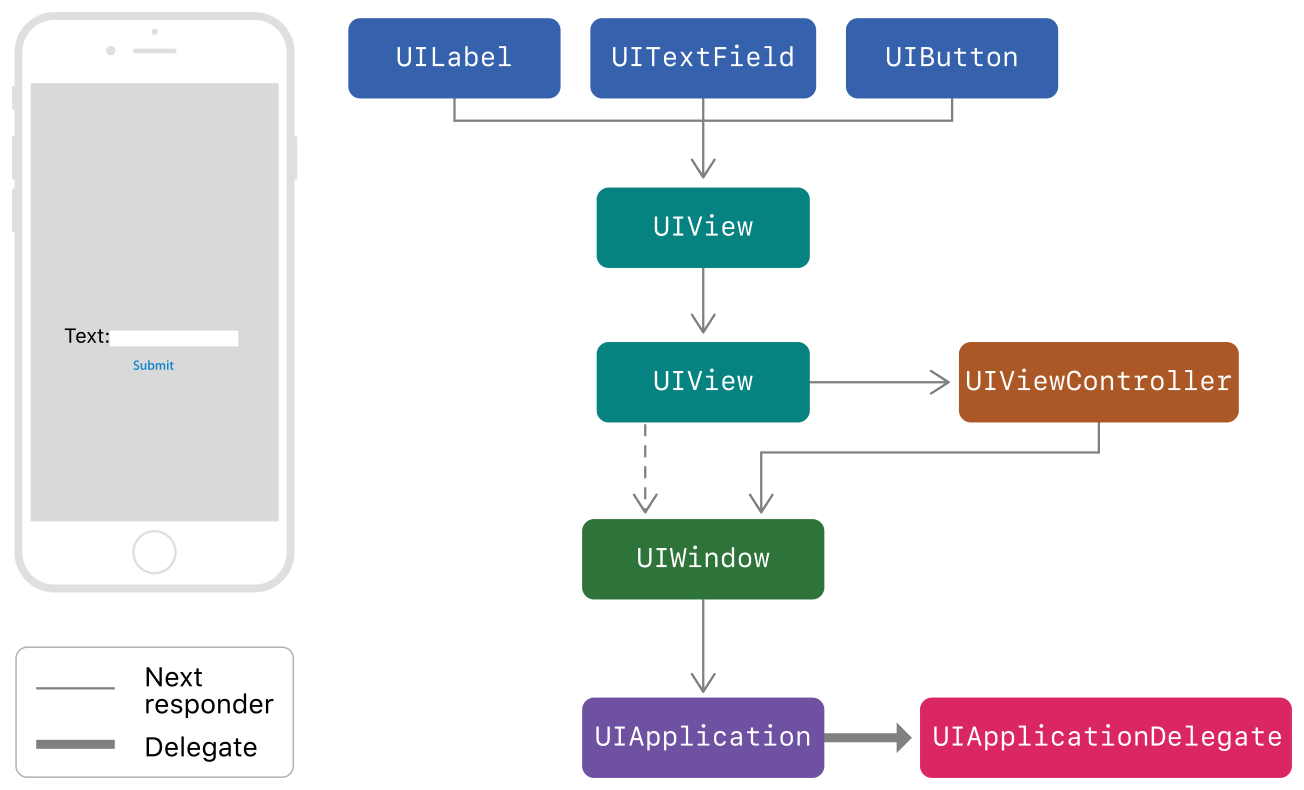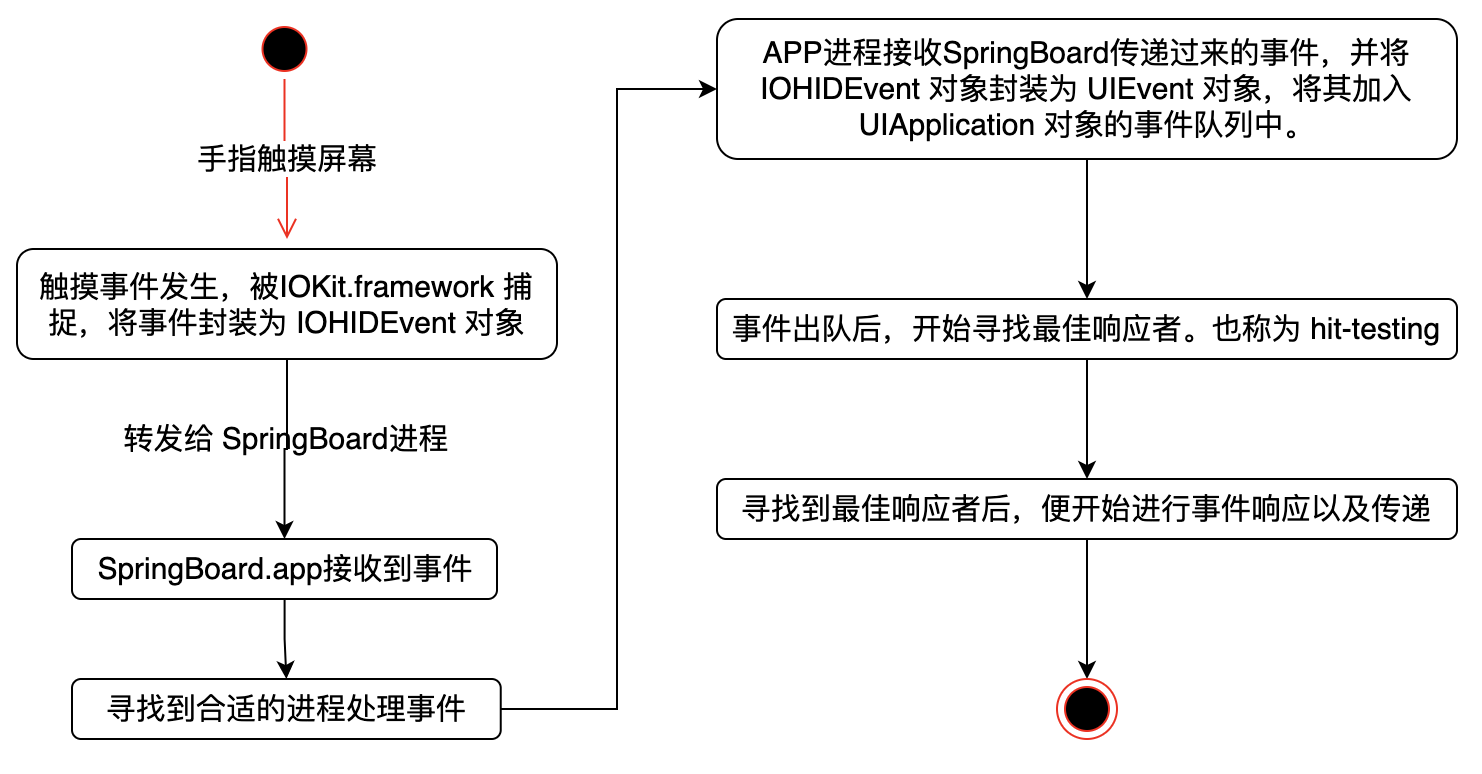前言
iOS 中有 8 种事件,本文重点介绍触摸事件的传递机制与响应流程。可以带着以下问题阅读:
- iOS 中有哪些事件类型,谁来进行事件的响应,怎么来响应呢?
- 触摸事件的传递与响应流程
hitTest方法的作用,它有什么实践场景?UIControl与UIGestureRecognizer也能响应触摸事件,UIResponder的响应方式有什么不同?
响应者 & 响应者链
- 响应者即
UIResponder class的一个实例; - 响应者链为响应者组成的一个链式结构,不同的链式结构组合起来看起来像一个倒过来的树形结构。
UIResponder中包含了许多处理事件的方法,如果我们想在这个对象里响应事件,那么重写这个方法即可。

- UIView:如果
view是UIViewController的root view,下一个响应者为UIViewController,否则下一个响应者为superview。 - UIViewController:如果
UIViewController的view是UIWindow的root view下一个响应者对象是window;如果 当前UIViewController由另一个UIViewController push或者presented,则下一个响应者为 弹出该vc的UIViewController,例如UINavigationController、UITableBarController。 - UIWindow:下一个响应者为
UIApplication - UIApplication:下一个响应者为
UIApplicationDelegate,前提是它不是UIView、UIViewController、以及不是UIApplication本身。一般来说,是指AppDelegate。
事件 & 谁是事件的第一响应者
| 事件类型 | 第一响应者 |
|---|---|
| 触摸事件 touch events | 发生触摸的视图 |
| 按压事件 press events | 被聚焦的对象 |
| 摇动事件 shake-motion events | 你(or UIKit)指定的对象 |
| 远程控制事件 remote-control event | 你(or UIKit)指定的对象 |
| 编辑菜单消息 editing menu messages | 你(or UIKit)指定的对象 |
| 加速器 accelerometers | 委任的对象 |
| 陀螺 gyroscopes | 委任的对象 |
| 磁力仪 magnetometer | 委任的对象 |
在 iOS 中,有 8 种类型的事件,响应这些事件的对象被称为响应者,系统的一些常见的响应者为 UIView、UIViewController、UIWindow、UIAppllication、AppDelegate,在找到最佳响应者后,如果事件没有被处理,事件会随着响应者链进行传递。不过有些事件在进行传递的时候,即使重写了响应事件的方法,特定对象不会进行响应,例如 shake-motion events 不会由 UIView、UIApplication、AppDelegate 进行响应。
- 触摸事件
touch events,是 iOS 中最常见的事件,每一次触碰都会由 IOKit 通过 IPC 交给 SpringBoard,进而通过mach port传递给合适的进程进行响应,第一响应者是发生触碰的视图,后面会重点讲解。
open func touchesBegan(_ touches: Set<UITouch>, with event: UIEvent?)
open func touchesMoved(_ touches: Set<UITouch>, with event: UIEvent?)
open func touchesEnded(_ touches: Set<UITouch>, with event: UIEvent?)
open func touchesCancelled(_ touches: Set<UITouch>, with event: UIEvent?)
@available(iOS 9.1, *)
open func touchesEstimatedPropertiesUpdated(_ touches: Set<UITouch>)
- 按压事件
press events,表示如遥控器或者游戏手柄中进行按压触碰而产生的事件,由当前聚焦的对象进行响应。
@available(iOS 9.0, *)
open func pressesBegan(_ presses: Set<UIPress>, with event: UIPressesEvent?)
@available(iOS 9.0, *)
open func pressesChanged(_ presses: Set<UIPress>, with event: UIPressesEvent?)
@available(iOS 9.0, *)
open func pressesEnded(_ presses: Set<UIPress>, with event: UIPressesEvent?)
@available(iOS 9.0, *)
open func pressesCancelled(_ presses: Set<UIPress>, with event: UIPressesEvent?)
- 摇动事件
shake-motion events,晃动设备进行触发。
open func motionBegan(_ motion: UIEvent.EventSubtype, with event: UIEvent?)
open func motionEnded(_ motion: UIEvent.EventSubtype, with event: UIEvent?)
open func motionCancelled(_ motion: UIEvent.EventSubtype, with event: UIEvent?)
- 远程控制事件
remote-control event,在音视频播放时,锁屏界面或者控制中心中点击 “上一个”、“下一个”、“暂停”和“继续”等操作时触发的事件。
@available(iOS 4.0, *)
open func remoteControlReceived(with event: UIEvent?)
- 编辑菜单消息
editing menu messages,编辑文本出现的菜单列表产生的事件。
open func buildMenu(with builder: UIMenuBuilder)
@available(iOS 13.0, *)
open func validate(_ command: UICommand)
@available(iOS 3.0, *)
open var undoManager: UndoManager? { get }
@available(iOS 13.0, *)
open var editingInteractionConfiguration: UIEditingInteractionConfiguration { get }
- 加速器事件、陀螺事件、磁力仪事件不跟随响应者链,
Core Motion将这些事件直接传递给指定的委任对象。
触摸事件流程

当触摸事件发生时,被用户面板即硬件由电信号采集到,之后再传递给 IOKit.framework,并将事件封装为 IOHIDEvent;之后通过 IPC 转发给 SpringBoard 进程;再由 SpringBoard 进程再次通过 IPC 将事件传递给合适的 APP 进程;由主线程 RunLoop 进行处理,先触发 source1 回调,后触发了 source0 回调,并将事件封装为 UIEvent;然后将事件加入 UIApplication 对象的事件队列中,出队后,开始寻找最佳响应者 hit-Testing,找到最佳响应者后。由 UIApplication 对象 从 sendEvent 方法将事件传递给 window 对象,再由 window 对象 sendEvent 到最佳响应者,随后进行事件响应以及传递。寻找最佳响应者以及事件响应后面会重点提及,这里先简单对 IOKit.framework、SpringBoard 以及 IPC 进行简单介绍:
- IOKit.framework:它为设备驱动程序(IOKit)的用户态组件,IOKit 来源于 NeXTSTEP 的 DriverKit,IOKit.framework 提供了内核态以及用户态双向通信的接口。
- SpringBoard:iOS 中的 SpringBoard 相当于 macOS 中的 Finder,它向用户提供了熟悉的图标界面,它记录了多触摸事件、加速器事件、按压事件等。
- IPC:macOS 和 iOS 中的进程间通信(InterProcess Communication) 是基于 mach,mach 是 iOS 和 macOS 中的核心,也是有别于其他操作系统的重点,mach 采用微内核的概念,即内核仅提供一些必要的功能,其他工作由用户态实现。mach 的 IPC 是通过在两个端口之间发送消息实现,具体可以参考 《深入解析Mac OS X & iOS 操作系统》。
寻找最佳响应者
- 由
UIApplication传递给UIWindow,如果有多个UIWindow对象,则按倒序进行查询。 - 对于每一个
UIWindow、UIView对象来说,也是倒叙查询其子视图和本视图能否响应。
如果从遍历方式来看,是一个反过来的 dfs。倒叙是因为如果有视图重叠,在上方的是后加入的对象;具体来说都是通过 UIView 的 hitTest 方法进行判断是不是最佳响应者,如果存在则返回该 UIView,不存在则返回 nil。
hitTest(_ point: CGPoint, with event: UIEvent?)模拟代码
override func hitTest(_ point: CGPoint, with event: UIEvent?) -> UIView? {
guard self.isUserInteractionEnabled && !self.isHidden && self.alpha > 0.01 else {
return nil
}
if self.point(inside: point, with: event) {
for subview in subviews.reversed() {
let convertedPoint = subview.convert(point, from: self)
let hitTestView = subview.hitTest(convertedPoint, with: event)
if let hitTestView = hitTestView {
return hitTestView
}
}
return self
}
return nil
}
需要
isUserInteractionEnabled为true、isHidden为fasle且透明度 > 0.01如果命中点在视图内,尝试倒序遍历子视图,查找是否有更合适的点,若有则返回子视图的
hitTest(),若无则返回本视图(self)。如果命中点不在视图内,则返回
nil。
point(inside point: CGPoint, with event: UIEvent?)模拟代码
override func point(inside point: CGPoint, with event: UIEvent?) -> Bool {
return bounds.contains(point)
}
- 判断当前 bounds 是否包含该点。
触摸事件的响应以及传递
找到最佳响应者后,UIApplication 对象 sendEvent 到响应该视图的 UIWindow,再有 UIWindow 对象 sendEvent 到最佳响应者,这一点可以通过查看调用栈帧看出:

传递给最佳响应者后,便可以进行事件的响应了,对于触摸事件来说,调用上述提到的 5 个方法即代表响应。事件的拦截是通过 open func touchesBegan(_ touches: Set<UITouch>, with event: UIEvent?) 实现的,传递方式与规则见上文中 响应者 & 响应者链:
- 不重写,默认将事件交给响应者链传递
- 重写不掉用
super.touchesBegan(touches, with: event),事件由该响应者处理,不进行传递 - 重写并调用
super.touchesBegan(touches, with: event),将事件交给响应者链传递
采用 touchesBegan 等系列方法以响应算是比较底层的方式,为快速响应各种类型的触摸事件,Apple 提供了 UIGestureRecognizer 与 UIControl 这两种方式。
UIGestureRecognizer
UIGestureRecognizer 手势识别器是处理视图中的触摸和按压事件的最好方式,如果我们仅用触摸事件基本响应方式进行处理的话,难度较大且不现实。它是一个基类,Apple 提供了 8 种手势,同时也可以创建自定义手势。
UITapGestureRecognizer:轻点手势UIPinchGestureRecognizer:捏合手势UIRotationGestureRecognizer:旋转手势UISwipeGestureRecognizer:滑动手势UIPanGestureRecognizer:拖拽手势UIScreenEdgePanGestureRecognizer:屏幕边缘拖拽手势UILongPressGestureRecognizer:长按手势UIHoverGestureRecognizer:指针悬停(macOS & iPadOS)
手势识别器分为离散型和持续性两种:
离散型手势在识别到手势后只调用一次 action 方法,其变化过程为:
识别成功:Possible —> Recognized
识别失败:Possible —> Failed
持续性手势在满足最初始识别条件后,会在手势信息变化中多次调用 action 方法,其变化过程为:
完整识别:Possible —> Began —> [Changed] —> Ended
不完整识别:Possible —> Began —> [Changed] —> Cancel
对于 UIResponder 的触摸响应优先级来说,UIGestureRecognizer 的响应优先级会更高一点;在 hit-Testing 过程中,就会判断当前 view 的手势识别器是否符合条件,符合条件的手势识别器对象会保存在 UIEvent 中,并在 sendEvent 时首先发送给它,如果手势识别器识别成功,则默认会取消剩余的触摸响应事件,表现为调用 touchesCancelled 方法。
三个重要的属性会改变上述过程:
cancelsTouchesInView:默认为 true,表示在识别手势成功后,是否取消剩余的触摸响应事件;delaysTouchesBegan:默认为 false,表示是否在识别手势失败后,才将触摸事件传递给hit-Tested view;delaysTouchesEnded:默认为 true,表示是否在识别手势失败后,才将touchesEnded事件发送给hit-Tested view;
手势冲突
手势默认是互斥的,但可以利用 UIGestureRecognizerDelegate 进行手势优先级处理。
UIControl
UIControl 是响应特定动作或意图的视觉元素的控件基类,它是 UIView 的子类,因此它也是响应者对象;UIButton、UISwitch、UISlider 等都是它的子类,也可以自定义 UIControl。通过 addTarget(_:action:for:) 指定响应事件和对象和方法,如果 target 为 nil,则按照响应链传递该事件。
open func beginTracking(_ touch: UITouch, with event: UIEvent?) -> Bool
open func continueTracking(_ touch: UITouch, with event: UIEvent?) -> Bool
open func endTracking(_ touch: UITouch?, with event: UIEvent?) // touch is sometimes nil if cancelTracking calls through to this.
open func cancelTracking(with event: UIEvent?) // event may be nil if cancelled for non-event reasons, e.g. removed from window
与 UIResponder 类似,UIControl 有 4 种跟踪触摸事件的方法,分别与 UIResponder 的 began、moved、ended、cancelled 相对应。如果查看其调用栈,可以发现在 UIResponder 方法内部调用了 UIControl 的跟踪方法。

如果在响应事件的方法打断点,查看调用栈帧,会发现 UIControl 会首先将事件通过 sendAction:to:forEvent: 发送给 UIApplication,再通过 sendAction 转发给发送的对象的对象。

与 UIGestureRecognizer 相比,事件仍会优先传递到 UIGestureRecognizer,这一点可以重写 UIGestureRecognizer 的 4 个响应方法验证。
如果 UIControl 是其子视图,会判断其是否为系统默认控件,系统默认控件则优先响应 UIControl 的 action 方法,如果为自定义控件,则默认优先响应 UIGestureRecognizer 的 action。值得注意的是,如果将 UIGestureRecognizer 的 cancelsTouchesInView 改为 false(默认为 true),则发现 UIGestureRecognizer 也会进行响应,个人理解为 cancelsTouchesInView 改变了响应互斥的特性,因此本身也会响应。
如果 UIControl 为父视图或平级视图,由于仍会优先将事件传递到 UIGestureRecognizer, 则可以根据其 cancelsTouchesInView、delaysTouchesBegan、delaysTouchesEnded 判断事件能否传递到 UIControl,这一点 UIControl 与 UIResponder 一致。
应用实践
扩大响应区域
- 重写本视图的
func point(inside point: CGPoint, with event: UIEvent?) -> Bool
override func point(inside point: CGPoint, with event: UIEvent?) -> Bool {
// 将响应区域扩大 30
return self.bounds.inset(by: .init(top: -30, left: -30, bottom: -30, right: -30)).contains(point)
}
- 重写父视图的
func hitTest(_ point: CGPoint, with event: UIEvent?) -> UIView?
override func hitTest(_ point: CGPoint, with event: UIEvent?) -> UIView? {
// 将响应区域扩大 30
// subView 为应扩大响应区域的视图
if subView.frame.inset(by: .init(top: -30, left: -30, bottom: -30, right: -30)).contains(point) {
return subView
}
return super.hitTest(point, with: event)
}
根据触摸实时修改 view 位置
override func touchesMoved(_ touches: Set<UITouch>, with event: UIEvent?) {
let touch = touches.randomElement()
let prePoint = touch?.precisePreviousLocation(in: self)
let currPoint = touch?.location(in: self)
if let prePoint = prePoint, let currPoint = currPoint {
let offsetX = currPoint.x - prePoint.x
let offsetY = currPoint.y - prePoint.y
self.transform = self.transform.translatedBy(x: offsetX, y: offsetY)
}
}
🔗
Using Responders and the Responder Chain to Handle Events
《深入解析Mac OS X & iOS 操作系统》